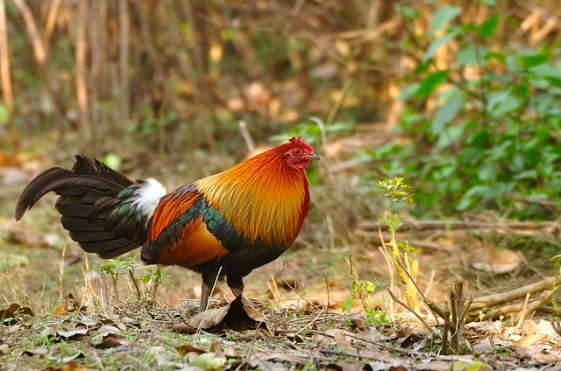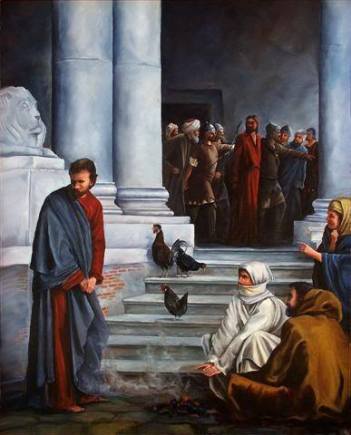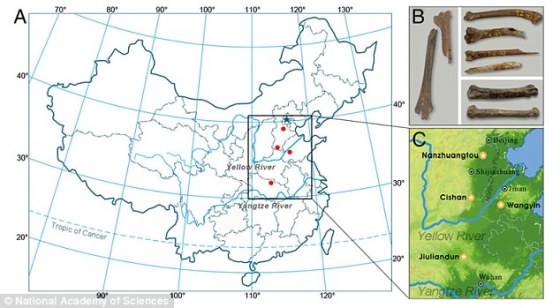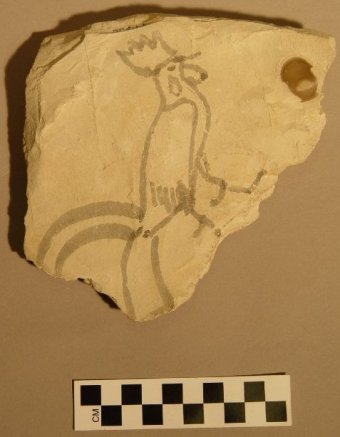Male Chicken Is the High Priests in the Bible
This Week's Lesson – Junglefowl in Judea?
Flood-pigeons, desert-quail – what could be next? Our topic this week is arguably the second most famous bird in the bible, following the pigeon and his Noah. We speak, of course, of the chicken, or more specifically, the male of the species, the cock.

Cock Red Junglefowl in all his glory, Corbett Nat. Park. northeast India (Rahul Pratti)
Peter replied, 'Everyone else may fall away on your account, but I never will.' Jesus said to him, 'I tell you, tonight before the cock crows you will disown me three times.' Matt. 26:33-34 New English Bible
Shortly afterwards the bystanders came up and said to Peter, 'Surely you are another of them; your accent gives you away!' At this he broke into curses and declared with an oath: 'I do not know the man.' At that moment a cock ( ἀλέκτωρ – alektor) crew; and Peter remembered how Jesus had said, 'Before the cock crows you will disown me three times.' He went outside, and wept bitterly. Matt. 26.73-75 New English Bible
The third time is the charm, as they say. All Christians ought to know of this story, as will many non-Christians. Who cannot feel both pity for poor Simon "Peter" (Πέτρος – Petros: Greek ** for rock), and embarrassed empathy with him in his cowardice and fear. How many of us would be courageous and foolish enough to declare faith and allegiance to Jesus, when he'd just been hauled off, probably to be executed, along with any followers who didn't slip away.

Peter, the rooster and Jesus; Copy of painting by Carl Heinrich Bloch 1834-90 (RonCarol205)
The story tells us that Jesus – well aware of Simon's rash and boastful tendencies – told him that despite his protestations of faithfulness unto death, Simon wouldn't even make it until the next dawn before "chickening out" three times. Yet, Jesus forgives Simon his weakness in advance.
This is one of the few tales found in all four Gospels. After the troops arrest Jesus, Simon follows them to see what will happen. Perhaps he will rescue Jesus! In three versions, Simon is alone; in John 18:15 he is accompanied by another disciple. He (or they), end up at the High Priest's house, where he mingled with others in the courtyard around a fire, trying to stay warm, (see picture above) yet still keep a low profile. But his northerner's accent gave him away as one of the Galilean followers of Jesus.
Mark 14:72 has the cock crowing twice; the other three passages agree on once. But we'll now leave Simon and Jesus to follow our own trail, which is to examine the third actor in this play, that crowing rooster, and see how he got to first century Judea and why he was crowing.
Anyone who has ever slept near a farmyard, anywhere around the world, knows that roosters (or cocks, as the male of the chicken and allied species are called, as in Peacock), call at dawn, waking us up whether we want to or not. Actually, nearly all birds with any kind of voice and who maintain personal territories, call around dawn during their breeding season, largely to let their avian neighbors know that they lived through the night and they'd better stay out of his territory. Most aren't as loud as the rooster, for whom it seems to be always breeding season.
Travelers to the tropics are often enchanted by the rainforest "dawn chorus'. Birds begin murmuring their nearly inaudible 'whisper songs' around first light, as if still groggy, get really loud around dawn, and dwindle away by ½ – 1 hour after dawn, when it's light enough for them to begin finding their first meal of the day. In fact this happens everywhere; but it's more noticeable when 500 species of birds sing within a mile of your bed. Cocks are no exception; his territory may consist of only a few bare square feet of ground, but it's his and he will fight to the death to protect it and his mating rights with any hens therein. In Muslim countries, cocks first crow at first light, when the Muezzin first calls the faithful to prayer, when the still-unseen sun tints, however slightly, the eastern sky.)
About one-third of the 174 members of the Phasianidae (Pheasant & Partridge family) are non-monogamous, including the Red Junglefowl (Gallus gallus), the official English name for our chicken species. Red Junglefowl are very sexually dimorphic, and the male has larger tail and fleshy comb, with overall brighter and more colorful plumage. The male maintains his territory by crowing and fighting with male intruders, using his bony spurs as weapons, and he gathers as many females as he can. Crowing, especially at dawn, is essential to the his survival, to fulfill his evolutionary imperative to get his genes into the next generation as often and as successfully as possible. Within his territory, the rooster "rules the roost."
According to the Oxford English Dictionary, the English name "cock" for the male chicken is from "kokke" in Old English, "coq" in 12th century French, and kokkr in Old Norse. All these names are likely echoic, imitative of its voice, as in "cock-a-doodle-doo." The name "rooster" comes from "one who roosts;" both males and females of many Phasianidae species spend the night safely roosting on tree limbs.
All domesticated animals originated somewhere; they haven't always lived in our backyards. Cattle originated in Europe, where wild cattle are long extinct; Ring-necked Pheasants ranged from western Georgia, east of the Black Sea, to east China; Guinea Pigs began in Peru, where they were a favorite food of the Incas. Red Junglefowl originated in Southeast Asia, where they still range from Nepal and central India eastward through Burma, Vietnam, and Malaysia to the Indonesian Lesser Sunda Islands. Their traditional range likely stopped at Bali, just west of the Wallace Line dividing Asian fauna from Austronesian fauna, but they now live throughout Sulawesi and the Philippines

Wallace Line – Bali is eastern end of Red Junglefowl range, excluding introductions by humans. (Wikimedia)
where they were introduced millennia ago. Their official English name, Red Junglefowl, comes from their original color and preferred habitat. Even now, they regally stalk silently through the forest undergrowth, scratching the soil for seeds, grubs, and grit, leading their precocial chicks on their daily search for food. It is a wonderful thing to hear the dawn territorial call of a cock Red Junglefowl in the dripping ink-black rainforest of Malaysia, and know that this bird has escaped the doom befallen so many of his brethren. It's even more wonderful to see them; both sexes are beautiful, magnificently plumaged birds. This pair, at least, will never suffer that most humiliating of all fates, to become a McNugget.
According to recent genetic studies, the clade of Red Junglefowl living at the western end of their range, in India, are the ancestors of all domestic chickens now found throughout the New World, Europe and the Middle East.

Location of chicken fossils, Yellow River area, China (Daily Mail)
In northern China, fossilized Chicken bones dating back 10,500 years were recently discovered in the Yellow River area, which DNA analysis determined to be Gallus gallus. This area is well outside the known historical range of the species and they are likely the oldest examples of domesticated chickens in the world. It is thought that the ancestors of this group were from southeast Asia – Vietnam for example – rather than from the Indian clade.

Ostracon of rooster c.1500 BCE, discovered by Howard Carter, 1923, while searching for King Tut's tomb. (British Museum)
An ostracon (inscription on potsherd) from fifteenth century Egypt depicts a cock. The Annals of Thutmose III (1558-1538 BCE), describing his battles in Babylonia, mentions bringing back to Egypt the "bird that gives birth every day." By the fifth century BCE they appeared in Lydia (Western Turkey) and Greece.
A Greek legend tells us that western civilization was saved by chickens! In 480 BCE, Athenian general Themistocles, leading his troops to fight Persian invaders stopped to watch two cocks fighting by the side of the road. He gathered his men to watch and said, "Behold, these do not fight for their household gods, for the monuments of their ancestors, for glory, for liberty or the safety of their children, but only because one will not give way to the other." The soldiers took heart from this – perhaps they didn't want to seem less courageous than chickens – and marched on to defeat the Persians, thereby saving Athens, Greece, Democracy and Western Civilization. Score one for the chickens, the very models of bravery.
Nowadays, chickens are found by the billions wherever humans live. We are surrounded by these fowl in so-called egg or chicken "factories," living lives that make our lives of quiet desperation (as Thoreau said) seem in comparison like ecstasy in paradise. We have thoroughly, remorselessly, and unremittingly domesticated them, but it wasn't always so.
Chickens then, as now, were common trade goods between peoples. These useful and easily maintained animals produce eggs, feathers and flesh; they're great predators of annoying pests in your garden; the males, equipped with sharp spurs on the back of their feet, are the central attraction of one of the world's oldest blood "sports" and gambling attractions. Such an animal would spread rapidly among all people who encountered them. Evidence suggests that the residents of Harappa in the Indus Valley not only had chickens, but they traded with the Middle East. Directly or indirectly, chickens were traded hand to hand, village to village, tribe to tribe, nation to nation, until they made their way to Persia, Syria, Egypt, Lydia, Greece and Judea, where they were common as dirt long before the birth of Jesus. Jesus and Simon may have walked from the Galilee to Jerusalem, but that rooster and his ancestors came a whole lot farther. They were so common in Judea that they were hardly worth mentioning, and wouldn't have been, if first century Jews couldn't reliably count on them as heralds of the coming dawn, when the new sun shines on us all.

Rooster on top of First Presbyterian Church, Wilmington, NC (MyReporter)
There is one – and only one – additional mention of chickens in the entire bible.
"O, Jerusalem, Jerusalem the city that murders the prophets and stones the messengers sent to her! How often have I longed to gather your children, as a hen (ὄρνις – ornis) gathers her brood under her wings, but you would not let me." Matthew 23:37
Had this image caught on, rather than that of the good shepherd with his lambs, it might have completely changed the course of Christian iconography. Imagine, if you can, Jesus as the "Hen of God," and all people as his chicks.
But chickens weren't completely overlooked by the new religion. Pope Nicholas I (858-867 CE) decreed that a figure of a rooster should be placed atop every church as a reminder of our story—which is why many churches still have rooster-shaped weather vanes.
I'll leave you with one final thought. People today often assume that commerce of goods and ideas between the Orient and the Occident was nearly nonexistent in ancient days. But we now see that chickens, tangible, living animals subject to loss, escape and death, were transported by humans through forests, deserts and rugged mountains, at least 2500 miles by land, well before the time of Jesus. What about intangible things? Our so-called "Arabic numerals" originated in India, where Persians discovered them and popularized them in the Middle East around 825 CE. We know that chickens preceded Arabic numerals by 2300 years. Might not ideas, ethics, philosophies, religious values and theological tenets have made their way back and forth even more easily? Perhaps the origins of the religions and philosophies of the Mediterranean and Middle East – the philosophy of Greece, the polytheism of Egypt, Greece, and Rome, the monotheism of Jews, Christians and Muslims – are not so local and insular as they appear on first glance.
For much more on the history of Red Junglefowl: Smithsonian – How the Chicken Conquered the World
And…just to shake the ground beneath our feet, here's another view which posits that the cock in our story was not a bird at all, but a horn!
**Bible Factoid #3 – New Testament Greek
You may have noticed that we are now translating from Greek, not Hebrew. The New Testament was written in Greek – not Hebrew, Aramaic, Latin and definitely not the English of the King James Version (1611). The language was not classical Greek, but Koine (street, common or vulgar) Greek . Koine, also called Hellenistic Greek, developed from the various classical Greek dialects and was the main spoken form from the time of Alexander the Great (died 323 BCE) until about the time of Tiberius II Constantine, circa 580 CE. New Testament Koine Greek was filled with local semiticisms, not used elsewhere in the Greek-speaking world. [Imagine if the King James Version had been written in modern Jamaican patois rather than Elizabethan English.]
After Alexander's conquest, the Middle East was ruled by Greeks (Hellenistic Period) until the Romans conquered the Middle-Eastern empire of the Seleucids in 63 BCE. Greek was the dominant cultural language, so much so that the Jewish Scriptures (the Christian Old Testament) were translated from the original Hebrew into Koine Greek, beginning in the third century BCE and finished in 132 BCE. This translation, called the Septuagint (frequently abbreviated LXX) for the 70 (or 72) scholars reportedly involved in the translation, is believed to have been commissioned by Egyptian King Ptolemy II Philadelphus and intended for the Library at Alexandria. In 1st century CE Judea, Hebrew was still spoken alongside Greek and Aramaic. Aramaic was dominant in Galilee and was probably spoken by Jesus and his followers. A few of the words of Jesus quoted in the Gospels are in Aramaic – abba (familiar form of father – "papa") and ephphatha ("be opened") for example.
Part I – What About That Dove? & The Flood of the Gilgamesh
Part II – Sandgrouse or Quail? & YHVH [יְהוָ֖ה] [Yahweh]
Part IV – Birds that Sow, Reap and Store & Whence Jesus (Ἰησοῦς)
Part V – The Friendly Raven & The Bar-Abbas Mystery
Part VI – The Humble Hoopoe & Catching "Forty" Winks
Part VII – The Wise Hoopoe & On "On"
Part VIII –Don't Eat That Bird! Part 1 & Of "Of"
Part IX – Don't Eat that Bird! Part 2 & Seeing "Red"
Part X – Don't Eat that Bird! The Last Bite & The Problems of Translation
[Chuck Almdale]
References not linked above
Handbook of Birds of the World (HBW), Vol. 2. del Hoyo, J., Elliott, A. & Sargatal, J. eds. (1994) Lynx Edicions, Barcelona. Pgs 452, 529-30.
New English Bible with the Apocrypha, The, Oxford Study Edition. Sandmel, Samuel, Suggs, M. Jack, Tkacik, Arnold J.; eds. (1972) Oxford University Press, New York
Oxford Companion to the Bible. Metzger, Bruce M. & Coogan, Michael D. eds. (1993) Oxford University Press, New York.
Additional Reading
How the Chicken Conquered the World. Adler, Jerry & Lawler, Andrew. Smithsonian Magazine, June 2012.
Male Chicken Is the High Priests in the Bible
Source: https://smbasblog.com/2016/08/28/junglefowl-in-judea-sunday-morning-bible-bird-study-iii/
0 Response to "Male Chicken Is the High Priests in the Bible"
Post a Comment